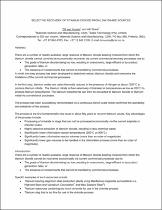JavaScript is disabled for your browser. Some features of this site may not work without it.
- ResearchSpace
- →
- Research Publications/Outputs
- →
- Conference Publications
- →
- View Item
| dc.contributor.author |
Van Vuuren, DS

|
|
| dc.contributor.author |
Stone, AK

|
|
| dc.date.accessioned | 2007-07-03T13:46:00Z | |
| dc.date.available | 2007-07-03T13:46:00Z | |
| dc.date.issued | 2006-09 | |
| dc.identifier.citation | Van Vuuren, DS and Stone, AK. 2006. Selective recovery of titanium dioxide from low grade sources. South African Chemical Engineering Congress 2006, Durban, 20-22 September 2006, pp 9 | en |
| dc.identifier.uri | http://hdl.handle.net/10204/937 | |
| dc.description.abstract | There are a number of readily available, large reserves of titanium dioxide bearing minerals from which the titanium dioxide cannot currently be economically recovered via current commercial recovery processes due to: The grade of titanium dioxide being too low, resulting in uneconomic, large effluent or by-product generation rates, or the presence of contaminants that cannot be handled by commercial processes. A novel, two-step process has been developed to selectively extract titanium dioxide and overcome the limitations of the current commercial processes. In the first step, titanium oxides are carbo-thermally reduced in the presence of nitrogen at about 1250°C to produce titanium nitride. The titanium nitride is then selectively chlorinated at temperatures as low as 200°C to produce titanium tetrachloride. The titanium tetrachloride can then be converted to titanium dioxide or titanium metal via conventional processes. The process has been successfully demonstrated on a continuous bench scale which confirmed the operability and selectivity of the process. The process is the first fundamentally new route in about fifty years to recover titanium values. Key advantages of the process include: Processing of minerals or slags that can not be processed economically via the current sulphate or chloride routes highly selective extraction of titanium dioxide, resulting in less chemical waste. Significantly lower chlorination reactor temperatures (200°C vs 900°C). Significantly lower chlorination reactor volumes (more than an order of magnitude). Significantly lower gas volumes to be handled in the chlorination process (more than an order of magnitude). | en |
| dc.language.iso | en | en |
| dc.subject | Titanium dioxide recovery | en |
| dc.subject | Titanium dioxide extraction | en |
| dc.title | Selective recovery of titanium dioxide from low grade sources | en |
| dc.type | Conference Presentation | en |
| dc.identifier.apacitation | Van Vuuren, D., & Stone, A. (2006). Selective recovery of titanium dioxide from low grade sources. http://hdl.handle.net/10204/937 | en_ZA |
| dc.identifier.chicagocitation | Van Vuuren, DS, and AK Stone. "Selective recovery of titanium dioxide from low grade sources." (2006): http://hdl.handle.net/10204/937 | en_ZA |
| dc.identifier.vancouvercitation | Van Vuuren D, Stone A, Selective recovery of titanium dioxide from low grade sources; 2006. http://hdl.handle.net/10204/937 . | en_ZA |
| dc.identifier.ris | TY - Conference Presentation AU - Van Vuuren, DS AU - Stone, AK AB - There are a number of readily available, large reserves of titanium dioxide bearing minerals from which the titanium dioxide cannot currently be economically recovered via current commercial recovery processes due to: The grade of titanium dioxide being too low, resulting in uneconomic, large effluent or by-product generation rates, or the presence of contaminants that cannot be handled by commercial processes. A novel, two-step process has been developed to selectively extract titanium dioxide and overcome the limitations of the current commercial processes. In the first step, titanium oxides are carbo-thermally reduced in the presence of nitrogen at about 1250°C to produce titanium nitride. The titanium nitride is then selectively chlorinated at temperatures as low as 200°C to produce titanium tetrachloride. The titanium tetrachloride can then be converted to titanium dioxide or titanium metal via conventional processes. The process has been successfully demonstrated on a continuous bench scale which confirmed the operability and selectivity of the process. The process is the first fundamentally new route in about fifty years to recover titanium values. Key advantages of the process include: Processing of minerals or slags that can not be processed economically via the current sulphate or chloride routes highly selective extraction of titanium dioxide, resulting in less chemical waste. Significantly lower chlorination reactor temperatures (200°C vs 900°C). Significantly lower chlorination reactor volumes (more than an order of magnitude). Significantly lower gas volumes to be handled in the chlorination process (more than an order of magnitude). DA - 2006-09 DB - ResearchSpace DP - CSIR KW - Titanium dioxide recovery KW - Titanium dioxide extraction LK - https://researchspace.csir.co.za PY - 2006 T1 - Selective recovery of titanium dioxide from low grade sources TI - Selective recovery of titanium dioxide from low grade sources UR - http://hdl.handle.net/10204/937 ER - | en_ZA |






